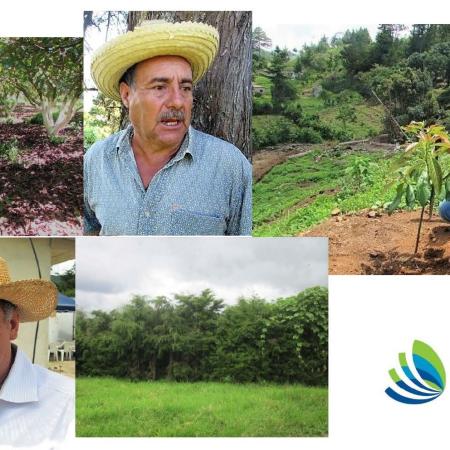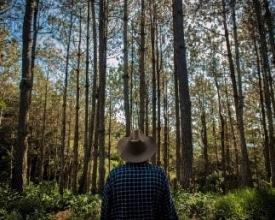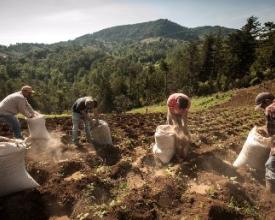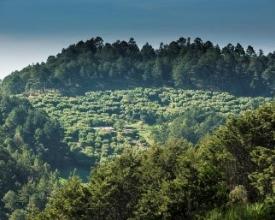
Sécurité alimentaire et hydrique des communautés du sous-bassin commun de la rivière Sumpul

La pénurie d'eau et les phénomènes météorologiques extrêmes sont déjà une réalité dans le sous-bassin du fleuve Sumpul, partagé par le Honduras et le Salvador, et risquent de s'aggraver à mesure que les effets du changement climatique s'intensifieront. Des mesures d'adaptation sont donc nécessaires pour accroître la résilience des systèmes de production et garantir l'approvisionnement en eau. Pour y parvenir, trois axes de travail ont été combinés : renforcer les capacités et les connaissances grâce à une approche d'"apprentissage par l'action" ; accroître la résilience des écosystèmes et des moyens de subsistance en mettant en œuvre des mesures d'adaptation fondées sur les écosystèmes (EbA) ; et revitaliser la gouvernance du sous-bassin. Cela a conduit à l'analyse des vulnérabilités des communautés, à l'application de mesures EbA dans les fermes adjacentes aux sources d'eau, au renforcement des capacités de gouvernance et de gestion des autorités locales, à l'articulation des actions par le biais du comité communautaire binational du sous-bassin et à la promotion de l'EbA en tant que réponse efficace au changement climatique.
Contexte
Défis à relever
- Le sous-bassin est confronté à des problèmes de dégradation de l'environnement dus à la déforestation et à la contamination du sol et de l'eau. Des conflits sont également apparus entre les voisins frontaliers au sujet de l'utilisation de l'eau de la rivière Sumpul.
- La nature binationale du bassin implique des défis de collaboration et de coordination entre le Honduras et le Salvador.
- La gestion locale des ressources en eau présente des faiblesses et les décideurs et dirigeants locaux connaissent mal l'adaptation fondée sur les écosystèmes et la façon dont la gestion de l'eau en est un élément central.
- Les principales menaces climatiques sont les suivantes : fortes variations des régimes pluviométriques, fluctuations extrêmes des températures ("gelées") et vents violents ; glissements de terrain, inondations et sécheresses récurrentes. Tous ces phénomènes entraînent des dommages aux infrastructures (logements, pépinières, etc.), à la production alimentaire et aux moyens de subsistance locaux (principalement les légumes et les céréales de base) et augmentent la vulnérabilité et la migration des personnes.
Emplacement
Traiter
Résumé du processus
Dans le sous-bassin partagé de la rivière Sumpul (El Salvador-Honduras), la gouvernance pour l'adaptation a été renforcée (BB3) et des mesures EbA ont été mises en œuvre avec les producteurs (BB2) dans le cadre d'une approche "learning by doing" ("apprentissage par l'action" BB1) qui combine des actions sur le terrain, l'échange d'expériences, la participation, le dialogue, les alliances et une vision de l'écosystème (BB2 et 3), et qui génère du capital social. La solution présente donc 3 Building Blocks (BB). Leur combinaison a permis de progresser dans la gouvernance communautaire d'un territoire binational (BB3), la capacité d'adaptation des communautés locales et la résilience de leurs moyens de subsistance (BB1 et 2), en particulier de leurs systèmes agroforestiers. La démonstration de la relation entre l'adaptation et l'approvisionnement en eau a également facilité l'extension de l'approche EbA (BB3) et son institutionnalisation dans des instruments politiques et de gestion, tels que le plan stratégique du comité communautaire binational du sous-bassin de la rivière Sumpul et les plans d'adaptation locaux des municipalités de Las Palmas et de San Ignacio (El Salvador). Ainsi, plusieurs objectifs de développement durable ont été atteints en articulant le capital social avec le capital naturel pour une plus grande résilience socio-environnementale face au changement climatique.
Blocs de construction
Apprentissage par l'action" et suivi pour accroître les capacités et les connaissances
Le fait d'aider les producteurs à mettre en œuvre des mesures d'EbA qui améliorent leurs pratiques de production et augmentent la résilience des agroécosystèmes génère un processus d'"apprentissage par l'action" qui permet à d'autres acteurs de constater les avantages de ces mesures et crée les conditions nécessaires à leur durabilité et à leur transposition à une plus grande échelle.
- La vulnérabilité socio-environnementale des communautés et de leurs moyens de subsistance est examinée, de manière participative, afin de hiérarchiser les mesures d'EbA et leur emplacement.
- Les producteurs bénéficient d'un soutien technique, complété par leurs connaissances traditionnelles, pour planifier et mettre en œuvre les mesures d'atténuation des effets du changement climatique (amélioration des systèmes agroforestiers).
- Des formations et des échanges d'expériences sont organisés sur la coopération transfrontalière, la gestion intégrée des ressources en eau, l'AbE, les cadres politiques et la législation sur l'eau et le changement climatique, ainsi que sur l'influence et la communication en matière de politique.
- Le suivi de la sécurité alimentaire et de l'eau est effectué avec 14 familles.
- Les capacités de gouvernance et de gestion des entités communautaires et municipales liées à la gestion des ressources en eau sont renforcées.
L'augmentation des compétences et des connaissances renforce le capital social et contribue à l'autonomisation des communautés et à la valorisation des services écosystémiques et de leur gestion au profit de tous.
Facteurs favorables
- Le changement climatique et, en particulier, la disponibilité de l'eau, sont des facteurs qui préoccupent les acteurs du sous-bassin, ce qui accroît leur volonté de participer au dialogue, à l'apprentissage permanent, à la recherche de solutions et d'actions conjointes.
- Plan Trifinio met en œuvre des mesures de conservation sur le territoire depuis des années et travaille en étroite collaboration avec les producteurs et les acteurs locaux. L'institution a également une grande expérience des processus participatifs, ce qui constitue un autre facteur favorable à la réussite des processus d'"apprentissage par l'action".
Leçon apprise
- Pour obtenir des changements au niveau du paysage, le travail doit d'abord se faire à la base, au niveau de la communauté. Pour ce faire, le renforcement des capacités des comités de l'eau, qui font partie des associations de développement communautaire (ADESCO), afin qu'ils puissent élargir le champ de leurs interventions au-delà des exigences en matière d'assainissement, a été crucial.
- Les échanges d'expériences (par exemple avec les acteurs du bassin de la rivière Goascorán et avec d'autres ADESCO d'autres parties du bassin) ont constitué un mécanisme efficace pour renforcer l'apprentissage collectif et démontrer les avantages de la collaboration transfrontalière.
Ressources
Mise en œuvre communautaire de mesures d'adaptation dans les forêts et les systèmes agroforestiers
Les mesures d'EbA mises en œuvre dans le sous-bassin se sont concentrées sur les services écosystémiques de l'eau et du sol, sur la diversification de la production et sur l'atténuation des effets du changement climatique sur les cultures et les biens de la communauté. En collaboration avec plus de 100 producteurs de la partie supérieure du sous-bassin, des arbres fruitiers et des arbres à bois ont été introduits dans des systèmes agroforestiers bordant 7 sources d'eau, et l'agriculture biologique a été encouragée, permettant aux familles de diversifier leurs revenus et de réduire la vulnérabilité de leurs cultures, de leurs infrastructures de production et de leurs habitations, qui sont touchées par des vents violents. Ces mesures, associées à des pratiques de conservation des sols et de l'eau (fossés d'irrigation à flanc de colline, non-brûlage et incorporation des résidus de culture), ont contribué à réduire l'érosion des sols causée par des précipitations extrêmes, ainsi qu'à améliorer la rétention de l'humidité dans les cultures, la fertilité des sols, l'infiltration et le captage de l'eau dans la région. Les mesures d'EbA ne génèrent pas seulement des agro-écosystèmes plus résistants, mais augmentent également la disponibilité de l'eau, ce qui profite à plus de 400 familles dans le sous-bassin. Ces actions ont permis de sensibiliser à la nécessité d'adopter des approches écosystémiques et adaptatives de la gestion territoriale face au changement climatique.
Facteurs favorables
- L'amélioration de l'état des sols n'est pas seulement un moyen de garantir une productivité accrue, mais aussi, à moyen terme, de réduire la tendance à l'agriculture migratoire, car elle permet aux familles d'exploiter les mêmes parcelles pendant de nombreuses années. Ce facteur d'influence favorise l'adoption de pratiques de conservation des sols par les familles.
- Le Plan Trifinio a lancé il y a plusieurs années un programme d'incitations forestières pour les propriétaires de forêts, dans le but de contribuer à leur protection et, par conséquent, au captage de l'eau dans le bassin.
Leçon apprise
- La plantation échelonnée de cultures avec des arbres fruitiers et des arbres à bois est un moyen très efficace de sensibiliser aux avantages de l'association d'arbres avec des cultures. Elle permet de voir concrètement comment les systèmes agroforestiers peuvent contribuer à lutter contre les effets du changement climatique et à diversifier les revenus des familles.
- La mise en œuvre de systèmes agroforestiers et de pratiques de conservation des sols devrait permettre de diversifier les cultures et d'augmenter les revenus à court terme (utilisation de céréales de base, d'avocats, etc.) et pas seulement à moyen et long terme (utilisation de pins et de cyprès). Pour que cela se concrétise, il faut une planification conjointe entre le producteur et le conseiller technique.
- Il est important de tenir compte du régime foncier des sources d'eau. Les municipalités ne possèdent généralement que les sources d'eau et non les terres qui les entourent. Il faut donc travailler avec les propriétaires des forêts et des terrains qui entourent les sources d'eau, afin de protéger et/ou de restaurer ces terres et de permettre l'installation de tuyaux pour approvisionner les communautés en eau.
Revitaliser la gouvernance pour l'adaptation
Pour être efficace, la gouvernance de l'adaptation doit être multidimensionnelle et participative, ce qui implique d'impliquer les agriculteurs, les municipalités, les ministères et autres institutions publiques de la région, les dirigeants communautaires, les unités de santé publique et les éducateurs dans la gestion de l'eau et les processus d'adaptation. Dans le cas de la rivière Sumpul, cet objectif a été atteint en particulier grâce à des processus d'"apprentissage par l'action" et à la revitalisation du comité communautaire binational du sous-bassin. Le travail et la légitimité locale du comité binational ont été enrichis par l'inclusion d'organes communautaires qui, pendant des années, ont été décousus et ont manqué de participation, tels que les comités de l'eau, qui sont des entités importantes dans chaque communauté. De nouveaux instruments de gestion ont également été créés, le leadership et la participation active des jeunes et des femmes ont été encouragés au sein du Comité binational, et des formations et des échanges d'expériences ont été organisés pour un apprentissage collectif. D'autres contributions à la gouvernance ont été apportées par les producteurs qui ont mis en œuvre des mesures d'EbA dans leurs exploitations (et qui sont désormais les porte-parole des avantages découlant de ces mesures) et par les municipalités (La Palma et San Ignacio) qui ont intégré l'approche d'EbA dans leurs politiques par la formulation de plans d'adaptation locaux.
Facteurs favorables
- L'existence préalable (depuis 2012) du Comité binational est un facteur habilitant clé, car il n'était pas nécessaire de partir de zéro, une structure existante a pu être renforcée par le biais d'une restructuration, après un diagnostic de ses opérations et de ses acteurs/leaderships clés.
- Pour que les comités de l'eau puissent contribuer à un modèle de gestion partagée avec une vision à l'échelle du bassin au sein du Comité binational, ils doivent d'abord améliorer leurs propres capacités d'organisation et de gestion, afin d'être mieux à même de défendre et de représenter leurs communautés.
Leçon apprise
- Le fait de disposer d'études biophysiques et d'informations techniques spécifiques sur les ressources en eau et l'EBA a facilité les processus de sensibilisation, de motivation de la participation, d'adoption d'accords et de mise en œuvre d'actions ciblées, ce qui a permis d'éviter la dispersion des ressources.
- L'amélioration de l'efficacité et de la durabilité des processus de gouvernance implique des efforts constants pendant de nombreuses années, qui dépassent souvent la durée des projets de coopération. Il convient donc de chercher, d'une part, à maximiser les synergies entre les projets et, d'autre part, à maintenir une présence et un accompagnement sur le territoire à travers des projets successifs.
Impacts
- Mise en œuvre de mesures EbA dans les systèmes agroforestiers (diversification des cultures, pratiques et travaux de conservation des sols, et protection des sources d'eau) bénéficiant à plus de 100 producteurs dans le sous-bassin.
- Meilleure articulation entre les acteurs clés du sous-bassin liés à la gestion intégrée des ressources en eau.
- Renforcement de 4 comités de l'eau dans la partie supérieure du sous-bassin (municipalités de La Palma et San Ignacio, El Salvador) et des règlements internes pour les systèmes d'approvisionnement en eau pour la consommation humaine.
- Formulation participative et adoption de nouveaux instruments de planification et de gestion pour les plateformes de gouvernance existantes (Comité communautaire binational du sous-bassin de la rivière Sumpul et 4 comités de l'eau, connus localement sous le nom de "conseils de l'eau" et faisant partie intégrante des associations de développement communautaire, ADESCO).
- Accompagnement technique par les municipalités de La Palma et de San Ignacio (El Salvador).
- Des capacités de communication et de plaidoyer accrues après la formation de 38 dirigeants communautaires à la négociation, à l'influence sur les politiques et à la communication.
Bénéficiaires
- >400 familles du bassin supérieur de la rivière Sumpul, en particulier >100 producteurs.
- Comités ADESCO de l'eau de 4 communautés
- Municipalités de La Palma et de San Ignacio (El Salvador)
- Comité communautaire binational du sous-bassin de la rivière Sumpul
Objectifs de développement durable
Histoire

M. Eduardo Santamaría S. :
"Pendant 36 ans, j'ai cultivé des choux et j'ai fini par changer d'activité pour produire des avocats".
Aujourd'hui, Eduardo produit des avocats, des choux et des céréales de base et possède une grande expérience des travaux et pratiques de conservation des sols, y compris des mesures d'adaptation fondées sur les écosystèmes, telles que l'utilisation de canaux d'irrigation (fossés) de niveau et de passage, le traçage de courbes de niveau, les barrières vivantes, les brise-vent, la gestion des résidus de culture et la lombriculture. Dans la forêt d'avocats d'Eduardo, il y a beaucoup de feuilles mortes et de matériel de taille, ce qui réduit le ruissellement, améliore l'infiltration de l'eau et la rétention de l'humidité dans les sols, prévient l'érosion et fournit de l'azote par sa décomposition.
"L'agriculteur a besoin d'être supervisé et aidé par un technicien. L'union des deux est essentielle pour produire des aliments plus sains et plus respectueux de l'environnement. L'objectif est de garantir la durabilité des systèmes agricoles et de réduire ainsi les effets du changement climatique."
M. Ignacio Salguero : "L'agriculture chimique ne m'a apporté que des maux de tête..." Il y a huit ans, Ignacio a décidé de changer ses méthodes agricoles conventionnelles et s'est lancé le défi de s'initier à l'agriculture biologique. Ayant hérité de sols déséquilibrés, de ravageurs et de maladies, il est aujourd'hui une référence en matière d'agriculture biologique dans la région du bassin supérieur, produisant de nombreuses cultures vivrières de manière écologique. Sa parcelle a été visitée par des fonctionnaires, des étudiants, des personnes du Honduras, du Guatemala, du Nicaragua, de l'Allemagne et du Salvador, dans le but d'observer les mesures de durabilité et les pratiques de conservation des sols qui y ont été développées.
"L'agriculture agroécologique, c'est la vie, c'est la santé, c'est le bien-être, c'est l'intégration familiale, c'est la qualité de vie, et celle-ci ne se trouve pas dans la richesse, mais dans la paix, la tranquillité, la stabilité, la sécurité, l'amélioration des marchés, la réduction des coûts de production. C'est ce qui m'a permis de surmonter la crise financière que l'agriculture chimique m'a laissée... Aujourd'hui, je m'endors satisfait et je peux travailler à mon rythme.
M. Noé Alvarenga : "Plan Trifinio et l'UICN nous ont donné des pins et des cyprès à planter... qui aident à protéger la source d'eau qui sert à irriguer quatre parcelles productives ; ils nous ont également donné 110 avocatiers que nous avons plantés dans une parcelle totalement abandonnée. Le terrain n'était que débris, c'était un fourré. Aujourd'hui, c'est génial ! Aujourd'hui, c'est déjà une parcelle de démonstration. L'avocat nous a renforcés ; il aide l'environnement et nous aide financièrement.


















